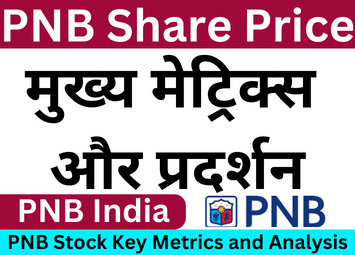Punjab National Bank (PNB) Stock Key Metrics and Performance
Are you considering an investment in Punjab National Bank (PNB) shares? It is important to grasp the stock’s essential metrics and performance indicators to make well-knowledgeable investment choices. In this article, we will explore PNB’s key statistics and assess its market performance.
Trade Value:
PNB’s trade value stands at 6483.53 (in Lacs), reflecting the total value of shares traded over a specific period.
Dividend Yield (%):
With a dividend yield of 0.50%, PNB offers investors a modest return on their investment in the form of dividends.
TTM EPS (Earnings Per Share):
The trailing twelve months (TTM) EPS for PNB is 5.81, indicating the portion of the company’s profit allocated to each outstanding share of common stock.
P/E Ratio (Price/Earnings Ratio):
PNB’s P/E ratio, calculated at 22.42, helps investors gauge the stock’s valuation relative to its earnings per share. A higher P/E ratio may suggest that the stock is relatively expensive compared to its earnings.
Book Value:
The book value per share for PNB stands at 87.79, representing the theoretical value of the company’s assets that shareholders would receive if the company were liquidated.
Face Value:
PNB’s face value is 2, indicating the nominal value of the company’s shares.
Market Capitalization (MCap):
PNB’s market capitalization is 1433083.67 (in Mn), reflecting the total market value of its outstanding shares.
Price/Earning (TTM):
The price/earning ratio based on trailing twelve months earnings is 22.42, providing insights into investors’ willingness to pay for each rupee of earnings generated by PNB.
Price/Sales (TTM):
With a price/sales ratio of 1.40 (TTM), PNB’s performance in generating revenue relative to its market capitalization is evaluated.
Price/Book (MRQ):
PNB’s price/book ratio (MRQ) of 1.48 compares the company’s current market price to its book value per share, indicating its valuation in the market.
PAT Margin (%):
PNB’s profit after tax (PAT) margin is 2.94%, representing the company’s net profit as a percentage of its total revenue.
ROCE (%):
The Return on Capital Employed (ROCE) for PNB is 5.54%, reflecting the efficiency of the company in generating profits from its capital investments.
Gaining an understanding of these important metrics can offer useful insights into PNB’s financial stability and its performance in the stock market. It is essential to perform comprehensive research and take into account different factors that may affect the stock’s future potential before making any investment choices.
Keep in mind that stock market investments carry inherent risks, and past performance may not necessarily predict future returns. Consulting with a financial advisor or conducting further analysis based on your investment goals and risk tolerance is advisable.
Conclusion:
In conclusion, by analyzing PNB’s key metrics and performance indicators, investors can make more informed decisions about whether to buy, sell, or hold PNB shares in their investment portfolios.
